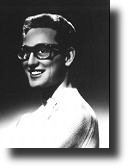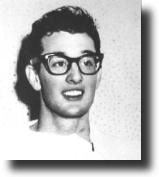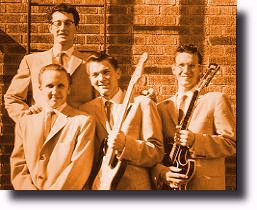 N
Nnotfadeaway
 N
N
| "It’s amazing what Buddy Holly did in his short lifetime. I’m really glad to have done a little something with his music... it’s perfect... perfect music." |
|
Robert Reynolds, member of The Mavericks |
As a songwriter working in the context of a self-contained rock & roll band, Holly became standard-bearer for such acolytes as the architects of the British Invasion, beginning with the Beatles, as well as such singer/songwriters as Bob Dylan and, a decade later, Bruce Springsteen. His unique and compelling vocal style and guitar technique have been widely imitated - consciously and unconsciously - by a vast array of rock and country artists over the years. And Holly’s attitude toward his music - an unbridled passion drove him to create his groundbreaking sound - has inspired all those artists who have refused to stick to the sonic status quo. Mixing elements of country, R&B, blues, rockabilly, gospel, and pop, Holly concocted a potent musical hybrid, resulting in a body of work that sounds just as vibrant and fresh today as it did three decades ago.
H
olly’s background gives little indication of what was to come. Born on September 7, 1936, in Lubbock, Holly spent his childhood in that dusty, windswept town on the West Texas plains where wide open spaces stretched as far as the eye could see. Without much to look at, perhaps the young Holly (ne Charles Hardin Holley) put more stock in what came to his ears.| "I’m a huge Buddy Holly fan... that goes without saying. It’s such a tragedy to music... that Buddy was lost. He’s been such an influence on music. I keep thinking about what he would have been doing now." |
|
Mark Knopfler |
At home, music was a constant: his mother sang around the house - mostly old folk songs and church hymns - and his brothers, Larry and Travis, both played instruments. The family listened to western music, particularly the work of such native sons as Bob Willis and his Texas Playboys. By the time he hit his teens, Holly had become addicted to the radio. Along with the C&W hitmakers of the early ‘50s - especially the plaintive poetry of Hank Williams - R&B and blues musicians greatly affected the former-child violinist. Having taken up guitar and banjo, Holly - before he could legally drive - had formed his first group, Buddy & Bob, which was initially based on such favorite country duos as the Louvin Brothers and Johnnie & Jack. His partner Bob Montgomery mostly crooned country tunes, while Holly belted the bluesier numbers.

H
owever, catching a 1954 show at Lubbock’s premier roadhouse, the Cotton Club, expand the boys’ musical horizons. Those who caught Elvis Presley’s early shows never forgot them - and Holly was no exception. Buddy and Bob’s laid back C&W sound gave way to an energized hybrid of country and R&B, which had just been tagged rockabilly. The duo expanded to a trio: bassist Larry Welborn helped emphasize their repertoire’s "bop," the word that was added after "wester" to the combo’s business card. Bookings increased too, and eventually industry folks in Nashville caught wind of Holly’s energetic performances.| "I knew Buddy for about eight years while he was recording country music. That was before he got into his own style and created that Rockabilly sound. I loved what he did... he had a lot of influence on me. Buddy was my friend, and that was the main thing between me and him. I was his protégé." |
|
Waylon Jennings |
By early 1956, impressed by Holly’s demos, Decca Records had summoned him (minus Bob) to Music City to sign a contract and cut some discs.
T
hat first session at the famed Bradley Barn studio in January 1956, found the greenhorn Texan, accompanied by homeboys Sonny Curtis on lead guitar and Don Guess on bass, along with some Nashville studio cats (including guitarist Grady Martin), struggling to put on wax his still-developing sound. Teamed with veteran country producer Owen Bradley, it was not a match made in heaven. Though Holly recorded two of his own compositions, the most successful of the four tracks turned out to be the bluesy "Midnight Shift," written by a little-known rockabilly and country songwriter form Alabama named Luke McDaniel (whose publishing byline was Jimmie Ainsworth / Earl Lee). A demo of the lusty song had been passed along to Holly by Jim Denny, the Grand Ole Opry’s booking agent who was convinced of the young Texan’s talent. The 20-year-old Holly’s recording of the song rang with confidence and cockiness. His insinuating and spirited vocal delivery gave every indication he was very familiar with gals like the song’s Annie.F
or his own recording of "Midnight Shift," however, Holly was not even permitted by Bradley to play guitar. Decca was disappointed, to say the least, with the results of that first session, as well as two subsequent ones. Holly’s contract expired, but the undaunted artist continued to concentrate his efforts on recording new songs at producer Norman Petty’s studio 100 miles west of Lubbock in Clovis, New Mexico.
After working with several hometown musicians, Holly finally settled on the lineup of drummer Jerry Allison, Bassist Joe B. Mauldin, and guitarist Niki Sullivan. Calling themselves the Crickets, the group found in Petty a kindred spirit when it came to song experimentation. Rather than charging by the hour, Petty charged by the song - and he was willing to work hard on the Texans’ demos. The results earned Holly and crew a new record deal, with Decca subsidiaries Coral (for Buddy Holly releases) and Brunswick (records by the Crickets), and, in August a #1 hit song, "That’ll Be The Day."
| "When someone like Paul McCartney says ‘If it wasn’t for the Crickets, there wouldn’t be any Beatles’, I say ‘Excuse me? I’d like to hear that again!" |
|
Jerry Allison, Original member of The Crickets |
T
he first half of 1957 was a particular fruitful period for the young recording artists. One of Holly’s best-known songs "Maybe Baby," was originally recorded at a Clovis session on March 12th. This version, a lovely, mid-tempo, country-sounding number, was never actually released, though. The boys recut the song later that fall during a tour stopover at the Tinker Air Force Base, in Oklahoma City. That second, faster rendition hit #17, the group’s fourth Top 20 single. Perfecting what would become a trademark vocal idiosyncrasy, Holly gave his song of love and hope a lilting vocal hiccup, accentuating the verses.T
wo months after Holly and the Crickets initially recorded "Maybe Baby" came the Bo-Diddleyisque "Not Fade Away." With all the brashness that only a young Texan on the brink of stardom could muster, Holly’s composition boasted, "My love’s bigger than a Cadillac."| "It was an exciting yet spooky thing to be recording with someone who has been dead for 37 years but I believe that we have helped to propel Buddy’s music further into the future. It was an honor to be able to ‘pay back’ Buddy for the pleasures he has given to all of us." |
|
Graham Nash |
On the Clovis recording, Jerry Allison played drums on nothing more than a cardboard box. The Crickets lead the background vocals and the distinctive, unforgettable chorus that has been immortalized by everyone from the Rolling Stones to the Grateful Dead to Bruce Springsteen.
| "Buddy Holly was a very rare talent who made over forty records, a lot of which he wrote all within the span of two years." |
|
Dave Edmunds |
H
olly and the Crickets recorded their second and third best selling singles that summer, "Peggy Sue" (#3) and "Oh Boy" (#10). The rollicking "Oh Boy" demonstrated that Holly himself had been inspired by such rock & ravers as Little Richard. With one of his raunchiest vocal attacks, Holly showed he was no honky crooner. The Texas songwriting team of Bill Tilghman (lyrics) and Sonny West (music) composed the song, which was backed with "Not Fade Away" when released as a single.I
n 1958, Holly decided to try his hand at writing songs for other artists to record. He enlisted his old Buddy & Bob collaborator Bob Montgomery, and the two come up with the Latin-flavored "Love’s Made a Fool of You" and the wistful ball "Wishing", that was originally intended for the Everly Brothers. To record the songs’ demos, Holly engaged Petty’s newly acquired session players at his Clovis studio.| "I’ve always thought that The Crickets were one of the great American bands. The Crickets have always made good music. You don’t have to think very long to remember a bunch of good songs they made over the years." |
|
Levon Helm, Drummer & Lead vocalist for The Band |
Lead guitarist Tommy Allsup and Holly really clicked, so thereafter the Oklahoma native joined the group for recordings and concerts (Sullivan had departed the year before).
S
ome of Holly’s most memorable songs were inspired by Texas gals. Holly’s 1958 recording in Clovis certainly anticipated the folk-rock sound, via Holly’s acoustic guitar and urgent, but softly sung vocals, Mauldin’s upright bass, and Allison lightly tippling a cymbal. The song’s lyrics also forecast the rebellion brewing in America’s teens: "Let people know about the dreams and wishes you wish... / In the night when lights are low/ Well all right, well... all right / We live and love with all our might." (unidentified man, Jerry Lee Lewis, Phil Everly and Buddy Holly) T
T
Backed for the first time by a full orchestra pre-dominated by strings, Holly recorded his gorgeous "True Love Ways"in Pythian Temple studio, in New York City, on October 21, 1958. Holly intended the song as a love ballad for his new wife, Maria Elena Santiago, whom he married August 15, 1958. Its recording marked a radical departure for Holly.
| "Even though Buddy says I influenced him with my guitar style, he certainly was an influence on me as well." |
|
Sonny Curtis, Guitarist & member of The Crickets |
H
olly’s Pythian Temple session that October evening also yielded the uncannily prescient "It Doesn’t Matter Anymore." Written by the Crickets’ new pal, then-teen idol Paul Anka (they became fast friends on American and Australian package tours), the song only arrived in Holly’s hands two hours prior to the session’s commencement. Producer and arranger Dick Jacobs hardly had any time to prepare the charts before the orchestra showed up. Nonetheless, Holly’s lilting vocals (the strings didn’t get in the way of those hiccups!) sound cool, calm, and collected. Released posthumously, the song soared to #13 in the days following Holly’s tragic death on February 3, 1959.W
hen the small twin-engine plane carrying Buddy Holly, the Big Bopper, and Ritchie Valens crashed in an Iowa cornfield on that frigid February night, it’s been said "The music died." It turned out, though, that along with the treasure of Holly’s studio recordings, he actually left behind a few more songs that he’s demoed (with just vocals and acoustic guitar) on his own Ampex recorder in the apartment he shared with his wife in New York. After her husband’s death, Maria Elena gave the tapes to Mr. and Mrs. Holley, who entrusted them to Norman Petty. With the public clamoring for more Holly material, Petty added overdubbing to the bare-bones recordings and the| "What is most striking about Buddy Holly’s legacy is the combination of lyrical innocence and the redemptive power of his music - to this day they define what is magical to me about rock n’ roll." |
|
Mary Chapin Carpenter |
songs were gradually released over the years. Holly’s first home demo was the cleverly arranged "Peggy Sue Got Married," a sequel to his second-biggest hit. Critics over the years have decried Petty’s overdone overdubbing of the song, which included the addition of surf guitar and busy drumming performed by a group called the Fireballs (remember "Sugar Shack"?).
A
bout a week after he demoed "Peggy Sue Got Married," Holly recorded another new one, "Crying, Waiting, Hoping." Again a frilly overdub added by Petty obscured the song’s original urgency.P
erhaps the most poignant of Holly’s home demos was the forth song he recorded on his Ampex, the bittersweet "Learning the Game." By December 1958, Holly had been through a lot.| "Buddy Holly is such a hero of mine. I always wanted to grow up and be a Cricket. Nobody played Stratocaster Like Buddy or Sonny (Curtis). They had just enough west Texas dirt underneath their fingernails. There was something about the way they played that made it special." |
|
Nanci Griffith |
B
ack in 1958, after Holly had co-written and demoed "Wishing" and "Love’s Made a Fool of You" specifically for his pals Phil and Don Everly to record, he personally delivered the tapes to the Everly’s manager Wesley Rose. Rose, for various reasons, turned down Holly’s proffered contribution, much to Holly’s disappointment. One can’t help but think that Buddy Holly would have been mighty pleased about the change in events over the past 35 years. And with the undying admiration and affection for his work that’s kept his music alive - Buddy Holly’s brilliant legacy is sure to endure as a new century unfolds.